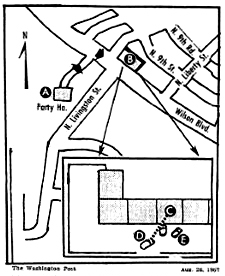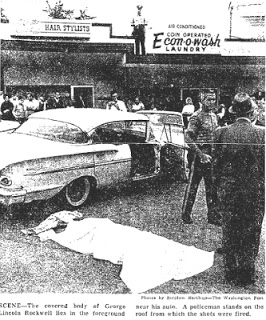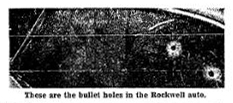 |
| George Lincoln Rockwell in front of the headquarters of the NSWPP, and his home, on Wilson Boulevard in Arlington. |
The Murder of George Lincoln Rockwell
Hadding Scott
adapted from Setting the Record Straight, 22 January 2011
 |
LOCALE — George Lincoln Rockwell drove from American Nazi Party headquarters (A) across Wilson Boulevard to shopping center (B). The sniper on the rooftop (C) in inset) fired two shots as Rockwell backed his car from parking lot (D). Car coasted to stop (E). (Washington Post illustration and caption.)
When the shots were fired2 17-year-old laundry attendant Robert Hancock looked up and saw the gunman on the 15-foot roof of the beauty salon (UPI, 25 August 1967). A barber named James Cummings saw a man later identified as John Patler, a.k.a. John Christ Patsalos, an expelled former member of Rockwell’s organization, leap from the south end of the shopping center and gave chase but lost him.
Somewhere in the range of 30 to 45 minutes after the killing Patsalos was spotted by police standing at a corner bus stop at the edge of a park about one-half mile from the shooting. He tried to run away but was caught and placed under arrest by Inspector Raymond S. Cole (UPI, 25 August 1967).
John Christ Patsalos was born in Bronx, New York. His family history is quite troubling. His father, an immigrant, served a term at Sing Sing for murdering John Patsalos’ mother in 1943 when he was five years old. (AP, 26 August 1967) He fought for custody of John and his brother on being released. (AP 26 August 1967) In 1996 the brother, Christ George Patsalos, was arrested in Jacksonville, Florida for having murdered his girlfriend in 1982. This was literally a family of murderers.
John Patsalos had a criminal history prior to adopting the name Patler and becoming a “Nazi.” He spent time in a New York youth-detention house where Patsalos boasted that another assassin, Lee Harvey Oswald, had once been held. One report says that he murdered a childhood friend.
Patsalos enlisted in the U.S. Marine Corps in 1958. In July 1960 he was given an honorable discharge on grounds of “unsuitability.” One report says that the discharge was due to his being arrested at an American Nazi Party event (AP 26 August 1967). He joined Rockwell’s organization in 1960 and around that time he started calling himself by the German-sounding surname Patler.
In 1961 Patsalos, now “Patler,” was put in charge of the American Nazi Party’s “Hate Bus,” which toured the South with a dozen stormtroopers. Patsalos made speeches in various Southern cities where there was notable conflict over “Civil Rights.” (AP 22 May 1961)
Patsalos edited and illustrated the NSWPP’s publication for members, The Stormtrooper, and drew cartoons found in Rockwell’s book White Power.
“A political guerrilla band is what we are. And under such conditions, the struggle for power is almost cannibalistic. What happened is Patler rebelled against the leadership– he thought he could do it better. He went up to New York and tried and he fell on his face. He’s ashamed of what he did. He’s apologized for it publicly. And he’s worked his head off. He’s a fine member right now.”
Having tried and failed to build his own organization, Patsalos sought and received readmission into Rockwell’s organization, but the incompatibility that had led to his resignation was still there.
Patsalos, in his and Dan Burros’ short-lived “American National Party,” had done away with all things “nazi.” Patsalos objected to this aspect of Rockwell’s organization even after rejoining, and had conflicts with other members because of it. As a swarthy Greek, Patsalos seems to have objected particularly to the Nordic ideal associated with National-Socialism. He referred to members lighter than himself as “blue-eyed devils” (NY Times, 26 August 1967).
Matt Koehl told reporters that Patsalos had exhibited “Bolshevik leanings,” and, “Communist thought kept creeping up in his work.” (UPI, 25 August 1967)
According to testimony given during his appeal before the Virginia Supreme Court in 1970, Patsalos said to another NSWPP member, “Rockwell is an evil genius and must be stopped.” (UPI, 1 December 1970)
Early in the summer of 1967, there was an attempt to kill Rockwell in the driveway of his house. Dr. William Pierce, who worked for Rockwell at the time, quotes Rockwell as saying that the gunman looked like Patsalos to him:
“About June of the next year, 1967, Rockwell drove out of the headquarters to run an errand. As usual he was accompanied by somebody when he went out. That wasn’t always the case, though–he could be very careless about his personal safety. There was a long drive, maybe one hundred yards, from the house down to the street, with forest on both sides. When Rockwell got back from his errands, there was some brush piled in the driveway. Rockwell was driving and had to stop, and the other guy got out of the car to clear the brush off the driveway so they could continue. It turned out that Patler had put the brush there and was hiding in bushes alongside the driveway. While the other guy was out of the car clearing the brush, Patler took a shot at Rockwell sitting in the car. It missed and ricocheted off the car just above the door where Rockwell was sitting. Rockwell, who was unarmed, jumped out of the car and began running toward where Patler was. Patler panicked and took off running through the woods with Rockwell at his heels. Patler was armed, Rockwell wasn’t, and Rockwell was chasing him. Patler was about twenty years younger and a faster runner and got away. Later I asked Rockwell who did it, and he said, ‘I couldn’t get a clear look at the guy, all I could see was his back–but I would swear it was John Patler.'” [W. L. Pierce quoted by R. Griffin, The Fame of a Dead Man’s Deeds].
Rockwell’s father, former vaudeville and radio5 performer George “Doc” Rockwell, age 78 at the time, said after learning of his son’s fate: “I’m not surprised at all.” (AP 26 August 1967) And, “He was more afraid of his own men than people were of him.”
At the time of the arrest, Patsalos was drenched in sweat, had roofing tar on the bottom of one shoe, and both shoes were wet, as were his pants up to six inches above the knee. A teenage girl had witnessed Patsalos hurrying away from the shopping center. (The Free Lance-Herald, 3o September 1967)
The day after the murder a C-96 Mauser “Broomhandle” was found “just below” a wooden foot-bridge under six to eight inches of water in a creek that runs through Bon Air Park, midway between the shopping center and where Patsalos was apprehended. (AP, 27 August 1967) Apparently it had rocks placed over it, since Four Mile Run is full of rocks and the prosecutor contended that Patsalos had knelt in the water while concealing the weapon.
The Arlington Police submitted it to the FBI’s crime lab for testing. (AP, 27 August 1967) Ballistics showed that this was the murder weapon. Patsalos had borrowed the unusual firearm from a party member in 1964 and never returned it. Patsalos had been seen target-practicing on his father-in-law’s farm, and slugs taken from a tree there confirmed that the gun found in the creek was the one that had been in Patsalos’ possession.
Based on this evidence Arlington County judge L. Jackson Embrey sent the case to a grand jury.
Patsalos loudly protested his innocence and never confessed anything. A conspiracy theory was propagated that Patsalos had been the victim of a frame-up by the ADL. Rockwell’s former deputy Karl Allen was a proponent of this theory.4 Karl Allen also raised money for Patsalos’ defense.
When the trial began on 27 November 1967, Patsalos was very well defended, with three attorneys. His attorneys’ strategy all along was to draw attention to flaws in the prosecution’s case or to try to create flaws by challenging the admissibility of crucial pieces of evidence, specifically the Mauser Broomhandle slugs found on his father-in-law’s farm, the admissibility of which was challenged on the first day of the original trial (Free Lance-Star, 28 November 1967) and in the final appeal before the Virginia Supreme Court in 1970.
One of the defense attorneys, Thomas J. Harrigan, tried but failed to have the case dismissed, alleging that the prosecutor, William J. Hassan, had piled inference upon inference and had failed to connect Patsalos with the crime. (AP 12 December 1967)
Some conspiracy-theorists have suggested that the Commonwealth of Virginia showed undue leniency to Rockwell’s assassin. While Patsalos did get a light sentence, it is easily shown that this was not the fault of the government.
It is sometimes claimed that Patsalos was released from prison after only three years. This is inaccurate.
John Patler, ambush killer of American Nazi Party leader George Lincoln Rockwell, Friday became the first major political slayer of the 1960s — America’s “Decade of Assassination” — to be freed. […] He had served eight years of a 20-year sentence….
[…]
“He was a model inmate who never caused any problems… that’s why he was paroled….” said Alan Brittle, of the state parole office. (UPI, 23 August 1975)
What confuses people is not really that Patsalos was treated leniently, but that they are sure that anybody who assassinated a prominent enemy of the White race would be treated with utmost harshness, which casts Patsalos’ treatment into stark relief.
To determine whether Patsalos was treated leniently by the Commonwealth of Virginia after his conviction, one would have to compare to other similar cases in the same state. In 1993 it was reported that the average prison inmate in Virginia serves less than a third of his sentence. (Virginian-Pilot, 2 October 1993) At that rate, Patsalos was not given any special leniency except initially by the jury that had recommended only a 20-year sentence. That was where Patsalos got lucky.
Today, John Patsalos lives in New York City.
The 32-year-old Milwaukee native assumed command on his own, but nobody questioned his right.
What was Koehl’s position in the NSWPP that enabled him to succeed Rockwell without being challenged?
In the 1966 Playboy interview, Koehl was identified by Rockwell as his “research chief,” who had determined that some photos of alleged Holocaust victims really showed victims of the bombing of Dresden.
More to the point, Koehl was publicly known as the deputy commander. As part of his conspiracy theory, Harold Covington claims that there was no reference to Matt Koehl as the Deputy-Commander of the NSWPP prior to Rockwell’s death. This is not true. On 14 April 1967, just a few months before Rockwell’s death, the Free Lance-Star of Fredericksburg, Virginia reported:
The Spotsylvania County American Nazi Party chapter is making plans to celebrate the birthday of Adolph Hitler next Thursday, April 20. […] Principal speaker will be Maj. Matt Koehl, deputy commander of the American Nazi Party and second in command to George Lincoln Rockwell.
It was also Matthias Koehl whom Rockwell named as executor of his will (J. Goolrick, The Free Lance-Star, 8 September 1967) and to whom he willed “my mortal remains, in the event of my death for whatever disposal he may care to make of such body.” (UPI, 28 August 1967) (UPI, 9 September 1967)
On the day of Rockwell’s death, Koehl said, “I don’t know of anyone who can fill his shoes. We cannot talk in terms of a successor to Commander Rockwell. But we’ll all do everything we can to carry on.” (AP 26 August 1967)
In fact Koehl was not able to carry on very well what Rockwell had started. Although loyal and trusted by Rockwell, he was not the right type of man for the position. The four-phase plan that Rockwell had outlined in This Time the World was abandoned entirely. The uniformed public demonstrations that had been intended as only a temporary gimmick to gain publicity, under Koehl became once again the organization’s main activity.
Why? Perhaps because the men who had been attracted to the organization for its hellraising aspect demanded it and were not interested in serious politics. Perhaps because other men, capable of subtler forms of activism, had not appeared in sufficient numbers. But the main reason seems to be the personal preference of Matt Koehl.
This is not to say that the NSWPP under Matt Koehl did no good whatsoever, but it did not follow the path into serious politics that Rockwell had intended. Uniformed “Nazi” groups in the USA generally follow the pattern set by Matt Koehl in the late 1960s and ’70s, rather than the course laid out by Rockwell.
It should be admitted that Rockwell’s plan was too ambitious to work, at least in terms of its stated goal of electing George Lincoln Rockwell as President of the United States in 1972. But, some transition in a more serious direction might have been feasible.
In the 1980s Koehl receded even farther from politics, sinking into mysticism and renaming Rockwell’s organization as the New Order. (Since Koehl’s death in 2014 New Order seems to have become more active in producing and distributing printed matter.)
The best legacy of Rockwell’s effort is probably the pro-White activist career of Dr. William Pierce, who contacted Rockwell and joined the cause after seeing reportage of Rockwell attempting to give a speech before of a hostile crowd. Rockwell offered an example of bold truthtelling and an attempt to educate the public against the anti-White agenda, in stark contrast to the apologetic and halfhearted, and ultimately worthless resistance offered by so-called responsible conservatives. That educational component of Rockwell’s effort became Dr. Pierce’s life’s work.
____________________________________
3. Dan Burros was later exposed as a Jew and allegedly shot himself in the apartment of Roy Frankhouser on 31 October 1965 after reading an article about himself in the New York Times. (Reading Eagle, 10 October 1967)
5. Doc Rockwell had been an occasional performer on Fred Allen’s radio show. (AP, 26 August 1967)


